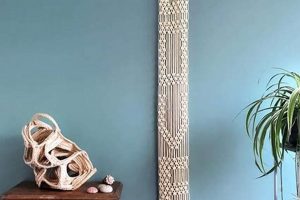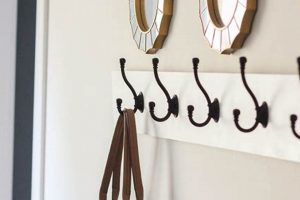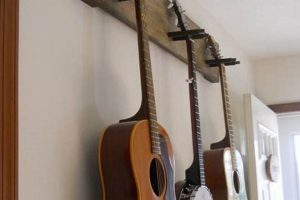Creating a custom entertainment center without professional assistance involves constructing a mounting and decorative structure for a television on a wall. This project typically includes concealing cables, integrating shelving or storage, and customizing the aesthetic to complement the existing dcor. For example, one might build a frame from reclaimed wood, paint it to match the room, and then securely mount the television within that frame, also concealing the associated wiring behind the structure.
The practice offers several advantages, including cost savings compared to professional installation and complete design control. Individuals can tailor the structure’s dimensions, materials, and style to perfectly suit their needs and preferences. Historically, homeowners would rely on traditional furniture to house their televisions; however, contemporary design trends favor wall-mounted solutions for space optimization and a cleaner aesthetic.
The subsequent sections will address the key considerations in designing such a feature, including material selection, structural integrity, cable management techniques, and aesthetic design choices. Specific attention will be given to safety measures to ensure secure mounting and avoid potential hazards.
Essential Considerations for a Custom Television Wall
Constructing a personalized television wall requires careful planning and execution. The following guidelines address critical aspects of the project, ensuring a functional and aesthetically pleasing result.
Tip 1: Prioritize Structural Integrity: Accurately assess the wall’s load-bearing capacity before commencing work. Drywall alone is insufficient for supporting a television’s weight. Locate studs and utilize appropriate mounting hardware designed for the television’s size and weight specifications. Consider reinforcing the wall with additional supports if necessary.
Tip 2: Plan Cable Management Meticulously: Concealing cables is crucial for a clean appearance. Install in-wall cable management systems or utilize paintable cord covers. Ensure adequate space within the wall cavity to accommodate all necessary cables, including power, HDMI, and network connections. Document the cable routing for future reference and maintenance.
Tip 3: Select Materials Strategically: Choose materials that complement the room’s existing decor and provide adequate support. Consider the weight and durability of materials such as wood, metal, or stone veneer. Ensure that all materials are fire-resistant and meet relevant building codes.
Tip 4: Incorporate Adequate Ventilation: Electronic components generate heat. Design the wall structure to allow for adequate ventilation around the television and other devices. Avoid enclosing components in airtight spaces. Consider incorporating ventilation grilles or fans to promote airflow.
Tip 5: Precisely Measure and Level: Accurate measurements are essential for a professional-looking result. Utilize a level to ensure that all components are aligned correctly. Double-check all measurements before cutting materials or drilling holes.
Tip 6: Account for Viewing Distance: Determine the optimal viewing distance based on the television’s screen size. Position the television at an appropriate height to minimize neck strain. Consider the viewing angles from different seating locations.
Tip 7: Integrate Lighting Strategically: Incorporate ambient lighting to enhance the viewing experience and reduce eye strain. Consider installing LED strip lights behind the television or within the wall structure. Avoid placing lights directly in front of the television, as this can create glare.
Implementing these recommendations ensures a secure, aesthetically pleasing, and functional integration of a television into the living space. Careful planning and execution are paramount to achieving a professional-quality result that enhances the overall viewing experience.
The subsequent section will explore common design styles and aesthetic considerations when constructing a feature of this nature.
1. Structural Support
Structural support is a foundational element in the successful execution of a do-it-yourself television wall. The connection stems from the necessity of safely and securely mounting a television, often a heavy and valuable electronic device, to a vertical surface. The absence of adequate structural support directly causes the risk of the television detaching from the wall, resulting in damage to the device, the wall itself, and potential injury to individuals in the vicinity. Consider, for example, a scenario where a homeowner, intending to create an entertainment center, mounts a 65-inch television, weighing approximately 50 pounds, directly onto drywall without anchoring to underlying wall studs. The insufficient support offered by the drywall will likely lead to the mounting hardware pulling free, causing the television to fall. Therefore, understanding and implementing proper structural reinforcement techniques is not merely an aesthetic consideration, but a fundamental safety requirement.
The practical significance of this understanding translates into specific actions. Homeowners must identify the location of wall studs, typically spaced 16 or 24 inches apart, and utilize mounting hardware designed to securely attach to these studs. When wall studs are not ideally positioned for the desired television placement, alternative strategies, such as installing a horizontal ledger board anchored to multiple studs, may be employed to provide a stable mounting surface. Furthermore, the load-bearing capacity of the wall itself must be assessed. In older homes, or when mounting a television to a non-load-bearing wall, additional reinforcement may be required to ensure the wall can withstand the weight of the television and the mounting structure. Proper assessment and reinforcement are critical steps that directly influence the longevity and safety of the do-it-yourself television wall installation.
In summary, structural support is an indispensable component of a do-it-yourself television wall. Neglecting this aspect introduces significant safety risks and potential for property damage. By understanding the principles of load-bearing capacity, stud location, and appropriate mounting techniques, homeowners can mitigate these risks and create a safe and aesthetically pleasing entertainment space. The primary challenge lies in accurately assessing the existing wall structure and implementing reinforcement measures that are both effective and compliant with relevant building codes. Successfully addressing these challenges ensures the long-term stability and safety of the installation.
2. Cable Concealment
Cable concealment is intrinsically linked to the success of a do-it-yourself television wall project. The visibility of numerous power cords and signal cables stemming from the television and associated peripherals detracts significantly from the aesthetic appeal of the installation. Consequently, the decision to embark on a television wall project necessitates a concurrent strategy for effectively managing and concealing these cables. The presence of dangling wires can undermine the visual impact of even the most meticulously designed wall feature. For example, a handcrafted wood panel, intended as a focal point, loses its impact if cluttered by a cascade of visible HDMI and power cables. The fundamental aim of a custom television wall, to elevate the viewing experience and enhance the room’s decor, is therefore compromised without adequate attention to cable management.
Effective cable concealment can be achieved through several methods, each with varying degrees of complexity and invasiveness. In-wall cable management systems, involving the installation of conduits within the wall cavity, offer a completely concealed solution. Alternatively, surface-mounted cable raceways, available in a variety of finishes, provide a less intrusive option. These raceways adhere to the wall surface and conceal cables within a channel. Another approach involves strategically routing cables behind the television and utilizing furniture or decorative elements to obscure their visibility. Irrespective of the chosen method, careful planning is essential. This includes anticipating the number and type of cables requiring management, selecting appropriate concealment materials, and ensuring compliance with electrical safety codes. Consideration must also be given to accessibility for future modifications or repairs to the cable infrastructure.
In summary, cable concealment is not merely an ancillary consideration but a core element of a successful do-it-yourself television wall project. Its impact on the overall aesthetic and functional integrity of the installation is substantial. Neglecting cable management results in a visually cluttered and unprofessional appearance, undermining the intended purpose of the custom wall feature. By prioritizing careful planning, employing appropriate concealment techniques, and adhering to safety standards, homeowners can achieve a clean and visually appealing television wall that enhances the overall viewing experience and complements the room’s decor. The ongoing challenge lies in balancing aesthetic goals with practical considerations such as accessibility and ease of maintenance.
3. Material Selection
Material selection is a critical determinant in the outcome of a do-it-yourself television wall project. It influences the aesthetic appeal, structural integrity, cost, and longevity of the finished product. Therefore, careful consideration of various materials is essential before commencing construction.
- Aesthetic Harmony
The chosen materials directly impact the overall aesthetic. Wood, for example, provides a warm, traditional look, while metal offers a more modern, industrial feel. The materials must harmonize with the existing room decor and reflect the desired style. A rustic reclaimed wood wall, while visually appealing in some contexts, might clash with a sleek, minimalist living space. Therefore, evaluating the aesthetic compatibility is crucial.
- Structural Performance
Different materials possess varying degrees of strength and weight-bearing capacity. A large television requires a robust support structure. Lightweight materials like MDF (Medium-Density Fiberboard) may be unsuitable for supporting heavy televisions without significant reinforcement. Conversely, solid wood or metal frames offer greater stability but may also increase the overall weight and cost of the project. The selection must balance aesthetic desires with structural requirements.
- Cost Considerations
Material costs can significantly impact the overall budget. High-end materials like exotic hardwoods or natural stone veneer can substantially increase expenses. Cost-effective alternatives, such as plywood or faux brick panels, offer similar aesthetic qualities at a lower price point. However, these alternatives may compromise durability or require more extensive preparation and finishing. Balancing budget constraints with desired aesthetics and structural needs is a key aspect of the selection process.
- Installation Complexity
The ease of installation varies depending on the selected materials. Working with wood generally requires woodworking skills and tools. Metalwork may necessitate welding or specialized fasteners. Materials like pre-fabricated panels or modular systems can simplify the installation process, reducing the time and skill required. Considering the homeowner’s skill level and available tools is essential when selecting materials.
In summary, material selection is a multifaceted decision point in the construction of a do-it-yourself television wall. The interplay between aesthetic harmony, structural performance, cost considerations, and installation complexity directly affects the success of the project. By carefully evaluating these factors and selecting materials that align with the project’s specific requirements and constraints, homeowners can create a functional, visually appealing, and long-lasting television wall that enhances their living space.
4. Ventilation
Adequate ventilation is a crucial, often overlooked, aspect of constructing a do-it-yourself television wall. Enclosing electronic components within a confined space without proper airflow can lead to heat buildup, potentially compromising performance, shortening lifespan, and posing safety hazards.
- Component Overheating
Electronic devices, including televisions, media players, and gaming consoles, generate heat during operation. Insufficient ventilation traps this heat, causing components to operate at elevated temperatures. Prolonged exposure to high temperatures can degrade internal components, leading to reduced performance, malfunctions, and premature failure. For instance, a media player enclosed in a tightly sealed compartment may experience reduced processing speed or even shut down due to overheating.
- Lifespan Reduction
Excessive heat accelerates the degradation of electronic components. Capacitors, a critical component in many electronic devices, are particularly susceptible to heat damage. High temperatures cause the electrolyte within capacitors to evaporate, reducing their capacitance and ultimately leading to failure. This accelerated degradation can significantly shorten the lifespan of the television and other devices housed within the wall structure. A television that might otherwise last for ten years could experience failure within five years due to inadequate ventilation.
- Fire Hazard
In extreme cases, overheating can pose a fire hazard. Components operating at high temperatures may ignite flammable materials in close proximity, such as dust, fabric, or even the enclosure itself. While modern electronics incorporate safety features to prevent catastrophic failures, the risk remains elevated in poorly ventilated environments. The potential for a fire underscores the importance of incorporating proper ventilation into the television wall design.
- Acoustic Performance Degradation
Some audio components, such as amplifiers, can experience performance degradation due to overheating. High temperatures can affect the linearity of amplifier circuits, leading to distortion and reduced sound quality. Furthermore, the cooling fans within some electronic devices may operate at higher speeds and generate more noise in an attempt to dissipate heat, negatively impacting the viewing and listening experience. Proper ventilation mitigates these acoustic issues by maintaining optimal operating temperatures.
The integration of ventilation solutions, such as strategically placed vents, fans, or open-backed compartments, is essential for mitigating the risks associated with heat buildup within a do-it-yourself television wall. Careful consideration of component placement and airflow dynamics ensures the longevity, performance, and safety of the enclosed electronic devices. The absence of adequate ventilation compromises the long-term viability and enjoyment of the entertainment system.
5. Precise Measurements
The success of a do-it-yourself television wall is inextricably linked to the accuracy of measurements taken throughout the planning and construction phases. The inherent complexity of integrating structural elements, mounting hardware, and electronic components within a defined space necessitates meticulous attention to dimensional details. Errors in measurement, however small, can propagate throughout the project, resulting in misalignment, structural instability, and aesthetic inconsistencies. For instance, an inaccurate measurement of the wall’s width, by even a fraction of an inch, can lead to a finished structure that fails to fit properly, necessitating costly rework or complete abandonment of the project. Therefore, precise measurements are not merely a procedural step but a foundational requirement for achieving a professional and functional outcome.
The practical significance of accurate measurements extends to various aspects of the construction process. Determining the correct stud spacing for secure television mounting hinges on precise identification and measurement of their locations. Cutting materials, such as wood panels or shelving, to the specified dimensions demands accuracy to ensure a seamless fit and a visually cohesive appearance. Furthermore, aligning the television at the optimal viewing height and ensuring its level installation relies entirely on precise measurements taken from the floor or other reference points. In situations where custom lighting or integrated storage is incorporated, accurate measurements are even more critical to ensure proper positioning and functional integration. The absence of precision in these areas manifests as visible imperfections, reduced structural integrity, and compromised functionality.
In summary, precise measurements are an indispensable component of a do-it-yourself television wall project. Their influence permeates every stage of the construction process, from initial planning to final assembly. Neglecting the importance of accuracy introduces a significant risk of errors, resulting in compromised aesthetics, reduced structural stability, and increased project costs. The challenge lies in consistently applying meticulous measuring techniques and utilizing appropriate tools to ensure dimensional accuracy throughout the project. By prioritizing precision, individuals can significantly enhance the likelihood of achieving a successful and satisfying outcome.
6. Viewing Distance
Viewing distance is a key determinant in optimizing the viewing experience within a custom-built television wall setup. It directly influences the perceived image quality, viewer comfort, and overall satisfaction with the entertainment system. An improperly calculated viewing distance, either too close or too far, negates the benefits of a high-resolution display and can induce eye strain or a sense of detachment from the screen. Consider, for example, a homeowner who constructs a television wall designed for a 75-inch television but positions the seating only six feet away. The proximity to the screen will result in a fragmented, pixelated image and potentially cause discomfort due to the excessive visual stimuli. Conversely, seating placed too far from the television, perhaps twelve feet away, diminishes the impact of the large screen and reduces the perceived detail in the displayed content. Therefore, accurate determination of optimal viewing distance is essential to fully capitalize on the investment in a custom television wall.
Practical application of viewing distance principles involves several considerations. The screen size, measured diagonally, is a primary factor in determining the ideal viewing range. General guidelines suggest a viewing distance of approximately 1.5 to 2.5 times the screen size. Thus, for a 65-inch television, the optimal viewing distance would fall between 8.1 and 13.5 feet. However, these guidelines are not absolute. Display resolution also plays a significant role. Higher resolution displays, such as 4K or 8K, allow for closer viewing distances without compromising image quality. Personal preferences, such as individual sensitivity to motion or visual detail, may also influence the ideal viewing distance. Furthermore, the content being viewed, whether fast-paced action movies or static documentaries, can affect the subjective perception of optimal viewing distance. A television wall design should, therefore, accommodate a flexible seating arrangement to allow for adjustments based on these various factors.
In summary, viewing distance represents a crucial element in the design and implementation of a do-it-yourself television wall. Its impact on image perception, viewer comfort, and overall satisfaction is substantial. By adhering to established guidelines, accounting for display resolution and personal preferences, and incorporating flexibility into the seating arrangement, individuals can optimize the viewing experience and maximize the benefits of their custom entertainment setup. The primary challenge lies in balancing theoretical recommendations with practical considerations of room size and individual viewing habits. Successfully addressing this challenge ensures that the television wall serves as both a visual centerpiece and a source of immersive entertainment.
7. Integrated Lighting
Integrated lighting, as a component of a do-it-yourself television wall, directly affects the visual experience and ambient environment. The strategic placement and controlled output of light sources can mitigate eye strain, enhance perceived contrast, and contribute to the overall aesthetic. The absence of integrated lighting or its poor implementation negatively impacts viewing comfort and the intended visual impact of the custom wall feature. For example, a television wall constructed with dark-colored materials, lacking any form of backlighting, may create an excessively high contrast ratio between the bright screen and the surrounding environment, leading to visual fatigue during extended viewing sessions. Conversely, well-placed bias lighting, positioned behind the television, reduces this contrast, promoting more comfortable viewing conditions.
Beyond mitigating eye strain, integrated lighting serves a practical role in enhancing the perceived picture quality. Backlighting, often employing LED strips, increases the perceived black levels on the television screen, resulting in a richer and more immersive viewing experience. Furthermore, the color temperature of the integrated lighting can be adjusted to complement the white balance of the television, ensuring accurate color reproduction and a more visually pleasing image. From an aesthetic perspective, integrated lighting allows for customization of the wall feature’s appearance. Recessed spotlights can highlight decorative elements, while ambient lighting can create a specific mood or atmosphere within the room. Examples of these integrations include: LED strip lighting mounted along the perimeter of the television to create a halo effect, accent lighting directed at artwork displayed on the wall, and dimmable spotlights used to adjust the overall brightness level of the room.
In summary, integrated lighting is not merely a decorative addition but an essential element of a well-designed do-it-yourself television wall. Its implementation directly impacts viewer comfort, perceived picture quality, and the overall aesthetic appeal of the installation. The challenge lies in carefully selecting lighting types, placement strategies, and control mechanisms that complement the television’s characteristics and the room’s decor. Successful integration of lighting transforms the television wall from a simple display into a cohesive and visually engaging component of the living space, promoting a more enjoyable and immersive viewing experience.
Frequently Asked Questions
The following questions address common concerns and misconceptions encountered when undertaking a do-it-yourself television wall project. The responses aim to provide clear and informative guidance based on established best practices.
Question 1: Is professional assistance required for constructing a television wall?
While professional installation ensures a guaranteed outcome and minimizes potential risks, constructing a television wall independently is feasible with careful planning and execution. Success hinges on a thorough understanding of structural integrity, electrical safety, and material properties.
Question 2: What is the most critical safety consideration when undertaking this project?
Ensuring adequate structural support for the television and all associated components is paramount. Improperly secured mounting hardware can lead to equipment failure and potential injury. Utilizing appropriate wall anchors and verifying load-bearing capacity are essential safety measures.
Question 3: How can cable management be effectively addressed in a do-it-yourself television wall?
Concealing cables contributes significantly to the aesthetic appeal of the installation. Options include in-wall cable management systems, surface-mounted cable raceways, and strategic routing behind furniture or decorative elements. Planning and selecting the appropriate concealment method are crucial for a clean and organized appearance.
Question 4: What factors influence the optimal viewing distance for a television wall?
Screen size and display resolution are primary determinants of optimal viewing distance. General guidelines recommend a distance of 1.5 to 2.5 times the screen size. However, higher resolution displays allow for closer viewing distances without compromising image quality.
Question 5: How can proper ventilation be ensured to prevent overheating of electronic components?
Enclosing electronic devices without adequate airflow can lead to heat buildup and potential damage. Incorporating ventilation grilles, fans, or open-backed compartments into the design promotes airflow and prevents overheating. Strategic component placement also contributes to effective ventilation.
Question 6: What are the key considerations when selecting materials for a television wall?
Aesthetic compatibility, structural performance, cost, and ease of installation are all important factors. Materials should complement the existing room decor, provide adequate support for the television and components, fit within the project budget, and be manageable for the homeowner’s skill level and available tools.
These FAQs offer a foundation for addressing potential concerns related to constructing a custom television wall. Addressing the structural aspect, cable management techniques, and optimal viewing distances are required.
The subsequent section will explore potential challenges and troubleshooting strategies associated with television wall projects.
DIY TV Wall
This exploration has illuminated the critical considerations involved in constructing a diy tv wall. Structural integrity, cable management, material selection, ventilation, precise measurements, viewing distance optimization, and integrated lighting have been identified as essential elements. Success requires a comprehensive understanding of these interconnected factors and a commitment to meticulous planning and execution.
The construction of a personalized entertainment center is an involved endeavor, demanding attention to detail and adherence to safety protocols. The long-term value lies not only in the enhanced viewing experience but also in the satisfaction derived from successfully completing a challenging project. Individuals are encouraged to approach this endeavor with diligence, prioritizing safety and seeking expert guidance when necessary. The result can be a transformative addition to any living space.







